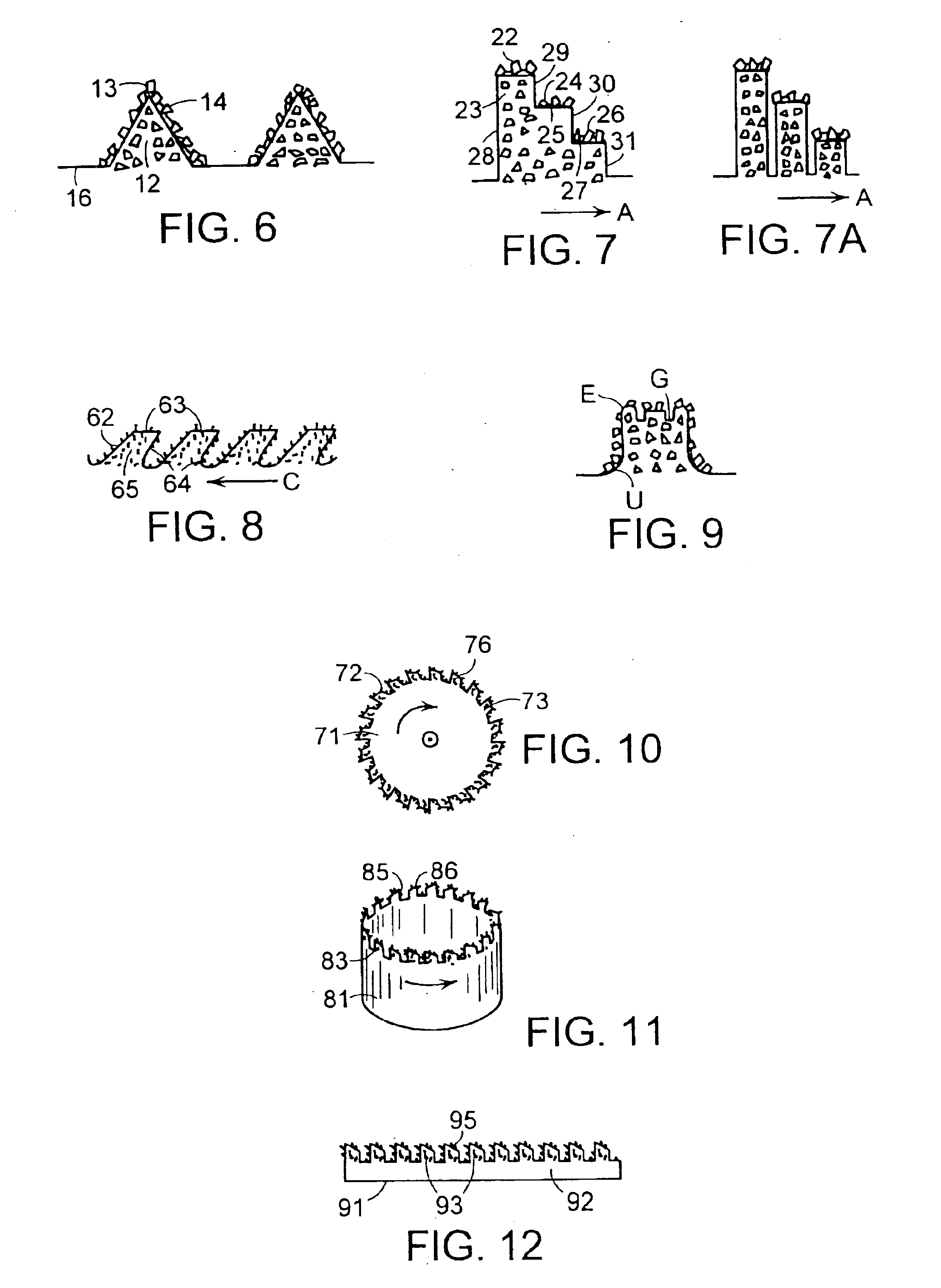Metal single layer abrasive cutting tool having a contoured cutting surface
a single-layer abrasive and cutting tool technology, applied in the direction of manufacturing tools, gear teeth, manufacturing apparatus, etc., can solve the problems of high penetration rate and high cutting rate, and the penetration rate of the tool quickly drops to zero
- Summary
- Abstract
- Description
- Claims
- Application Information
AI Technical Summary
Benefits of technology
Problems solved by technology
Method used
Image
Examples
example i
[0083]In this embodiment, core drills of the present invention were made using 66 mm diameter outlet bits having a 2 mm wall thickness and made of 1020 steel having a 38-42 Ra hardness. The contour of the cutting surface was substantially similar to that shown in FIG. 9.
[0084]The crown of the bit was contoured by turning a 1 mm radius onto the leading edge of the steel substrate and then milling nine 0.050 inch wide slots spaced equally around the periphery. This procedure produced nine 0.402 inch wide, 0.200 high teeth. Two equally spaced radial grooves (0.0625 inches wide, 0.0625 inches deep) were then ground into the face of each tooth. A 0.035 inch layer of bronze titanium was then applied to the teeth and a layer of 35 / 40 SDA 100+ diamond (about 450 mg) was applied to the braze surface and the resulting assembly was placed in a vacuum furnace for conventional braze curing.
[0085]Bits made in accordance with this example were used to hand drill heavy weight concrete HCB blocks. A...
example ii
[0086]In this embodiment, tools of the present invention were made using 66 mm diameter outlet bits having a 2 mm wall thickness and made of 1020 steel having a 38-42 Ra hardness. The contour of the cutting surface was substantially similar to that shown in FIG. 8.
[0087]A single layer of abrasive grain consisting essentially of 0.5 g of 35\40 mesh SDA 100+ diamond and bronze-titanium braze was applied to the contour of each bit.
[0088]These bits were use to drill holes in HCB blocks. Initial penetration rates were about 3-4 inches a minute. Although the diamond on the leading edge of the contour was worn away after only a few holes, the bits continued to drill over four meters of concrete block. When the tests were suspended after each bit drilled 80 holes, the bits were still drilling at an acceptable rate of about 1.5-2 inches (3.8-5 cm) per minute. Drilling power varied between about 350 and 550 watts over the course of the test, while specific energy varied between about 0.30 and...
example iii
[0089]This test examined the behavior of a hole saw having a reversed tooth orientation. The tooth configuration in this case was similar to that of Example II, except that the angle of orientation was reversed so that the descending portion of the tooth was the leading edge, thereby producing positive rake. These tools were tested under conditions substantially similar to those of Example I. After drilling only 5 cm, the teeth were so worn that only 20% of the height of the tooth remained. (In contrast, this level of wear was found in the teeth of Example II only after a full 400 cm of drilling.) This tool drilled for 396 cm before the penetration rate fell below 2.5 cm / min and had an average penetration rate of 5.4 cm / min. Accordingly, the tool having teeth oriented for a negative rake produces superior results.
[0090]The results of the above tests are summarized in Table I.
[0091]
TABLE ITESTDistance Drilled (cm)Speed (cm / min)C. E. I100—C. E. II4005.3C. E. III003—E. I490-5605E. II98...
PUM
| Property | Measurement | Unit |
|---|---|---|
| angle | aaaaa | aaaaa |
| angle | aaaaa | aaaaa |
| angle | aaaaa | aaaaa |
Abstract
Description
Claims
Application Information
 Login to View More
Login to View More - R&D
- Intellectual Property
- Life Sciences
- Materials
- Tech Scout
- Unparalleled Data Quality
- Higher Quality Content
- 60% Fewer Hallucinations
Browse by: Latest US Patents, China's latest patents, Technical Efficacy Thesaurus, Application Domain, Technology Topic, Popular Technical Reports.
© 2025 PatSnap. All rights reserved.Legal|Privacy policy|Modern Slavery Act Transparency Statement|Sitemap|About US| Contact US: help@patsnap.com



